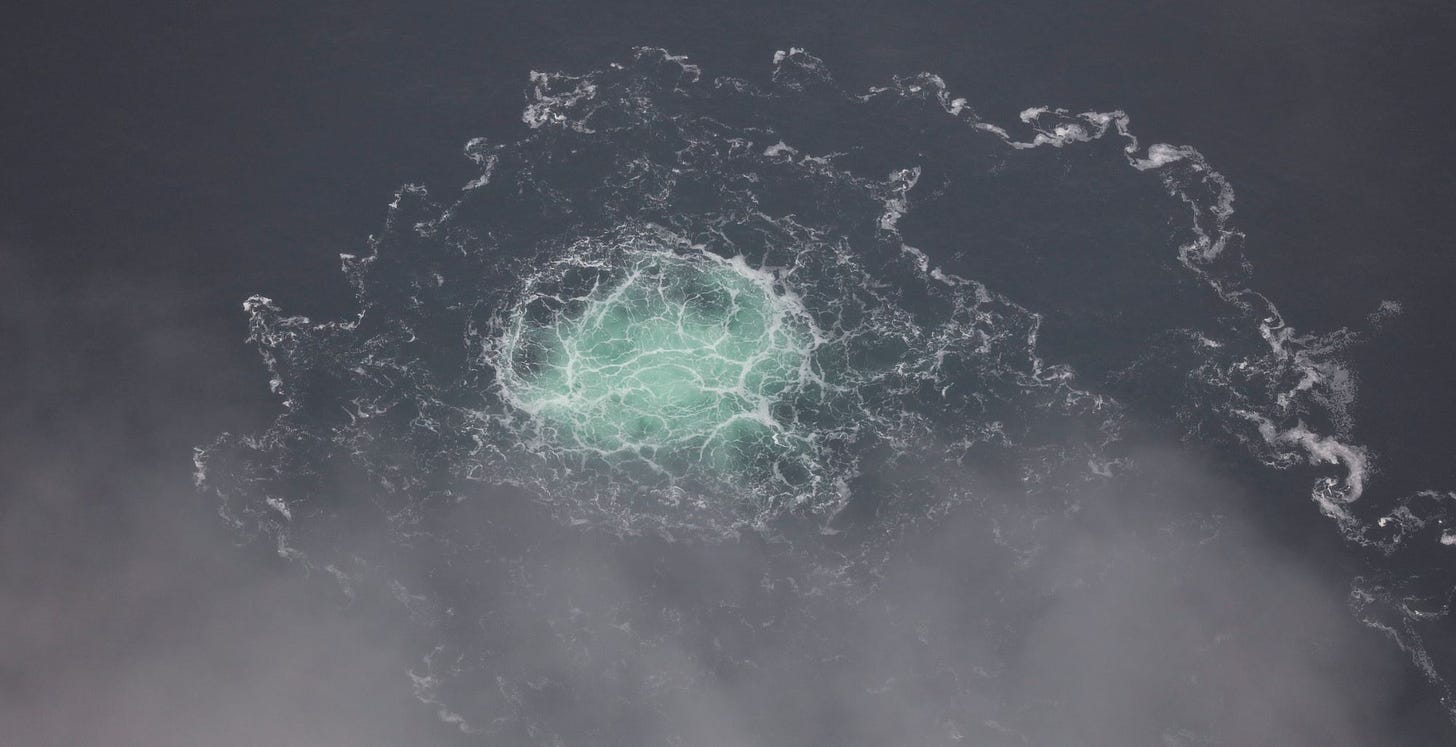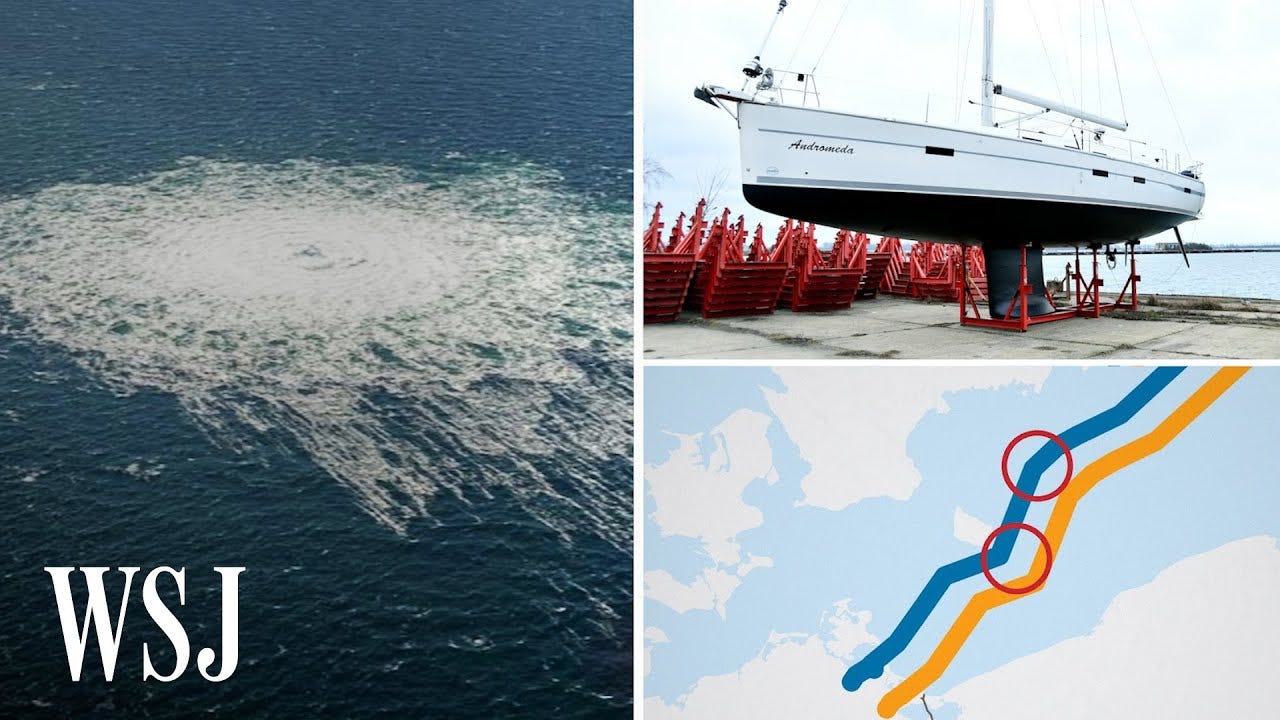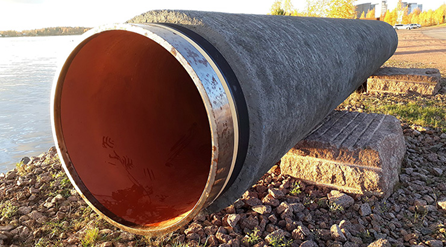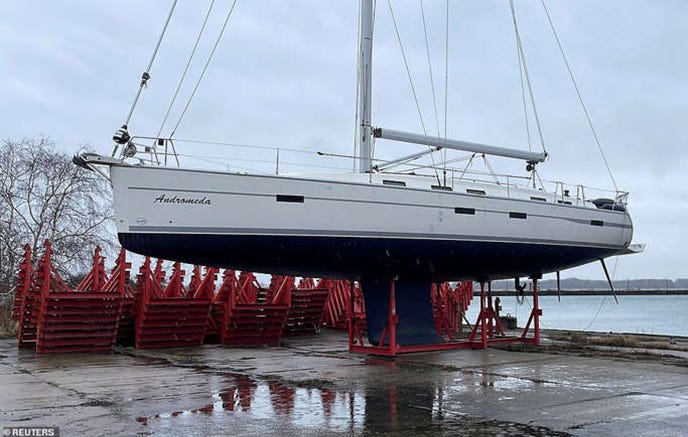The WSJ's "Real Story" of Nord Stream Sabotage Doesn't Add Up
EXCLUSIVE: The WSJ's "Real Story" of Nord Stream Sabotage Doesn't Add Up
What really happened to the Nord Stream pipelines in September 2022?
Background
Submitted/Edited by Goldfix; Authored by Matt Riley's Substack
A recent Wall Street Journal article titled: A Drunken Evening, a Rented Yacht: The Real Story of the Nord Stream Pipeline Sabotage claims a rogue Ukrainian general, Valeriy Zaluzhniy, and a small team of commandos were responsible for the September 2022 destruction of the Nord Stream pipelines. However, this report offers little new information, mostly rehashing details that surfaced over a year ago. That article’s timing and content raise questions about its intent, particularly given the complexities involved in such a high-stakes operation.
Matt Riley argues below that the operation described by the WSJ is highly improbable. His main points summarized are:
- The Nord Stream operation required capabilities far beyond those of the alleged perpetrators.
- The WSJ story seems more like a strategic narrative designed to distract from the real culprits and manage geopolitical tensions, with potential darker motives behind its publication.
- The suggestion that Zaluzhniy, now the Ukrainian Ambassador to the UK, could be targeted in a false flag operation to further escalate tensions with Russia is particularly concerning.
- The whole narrative appears to be setting the stage for a possible escalation, leveraging public perceptions to justify further conflict.
This is a detailed explanation by Matt Riley, a former Naval Marine Engineer Diving Officer and Intelligence Interrogator. Only [Subtitles] were added
Contents: (2500 words)
- [ The WSJ "Bombshell" Report ]
- [ Feasibility of this Operation ]
- The Dive Itself
- Operational Risk
- [ Breaking Down The Actual Dive ]
- What’s Different? & Why Now?
- [ Zelensky’s Pre-Selected Fall Guy ]
- [ Pretense for Greater War With Russia? ]
- [ Looking Forward ]
Debunking The WSJ Nord Stream Article
What really happened to the Nord Stream pipelines in September 2022? More importantly, why did the Wall Street Journal recently publish a “BOMBSHELL” article with only one new piece of information?
Most can agree the destruction of the Nord Stream pipelines constitutes the greatest act of industrial sabotage in history, as measured by the financial value of the infrastructure destroyed and further damage to the European economy. Combined, the pipelines cost 19 billion dollars to construct and provided the cheapest and most reliable energy to the European manufacturing base. E.U. natural gas prices skyrocketed while there were cold shower PR campaigns and home heat getting shut off. Estimates of the negative impact to the German economy alone range from 1.5%-3.5% drop in GDP. Although, it is difficult to separate the negative impacts of Nord Stream going offline from the near simultaneous (and truly insane) dismantling of the German nuclear power industry.
[ The WSJ "Bombshell" Report ]
According to their recent “Bombshell” reporting the Wall Street Journal would have us believe that a rouge Ukrainian General Valeriy Zaluzhniy and a merry band of six Ukrainian commandos pulled off the entire Nord Stream demolition from the 50ft sailboat Andromeda pictured below.
For starters, this reporting is not new, and it is not “Breaking.” Many news outlets across the world were reporting all about this story in spring /summer of 2023. Reports from that time detailed the same specific yacht, DNA from the boat matched at least one Ukrainian soldier, the explosive was HMX, and a six person “dive team”. There are other minor details from the WSJ “bombshell” that match earlier reports. It really begs the question; what is new in the WSJ article, and why is it coming out now? We will get to that later, but first let’s explore why the operation described in the WSJ article is a complete fantasy.
[ Feasibility of this Operation ]
The tactical planning and level of execution required to successfully destroy both Nord Stream pipelines is no small feat. First, you need to find the pipelines with a high level of certainty, then have enough divers and/or high-end diving equipment to support enough time at depth or Bottom Time (BT) to get the job done, and finally you would place enough high explosives at four separate sites to destroy a pipe made of 1.6 inch thick steel with 4.3 inches of concrete insulation.
Make no mistake, while this operation certainly has its complexities, the required tactical level planning and execution is well within the capabilities of most NATO countries. For the US, UK, and Russian special operations communities, it’s just another day at the office. But even those top tier military divers would have a near impossible, if not impossible, time trying to complete the operation as described by The Wall Street Journal. There are also operational planning factors we haven’t considered yet.
Political decision makers desire certainty, and it’s something they strive for with every covert military operation. Some operational planning factors they consider are probability of success, attribution, and severity of retribution if caught. The probability of success for the operation described by the WSJ would be incredibly low solely based on the complexity of the diving involved. Additionally, the risk of attribution would be much higher than most decision makers would tolerate. And if the supposed Ukrainian operation were discovered, then the world would know Ukraine was guilty of attacking what might be the single most important piece of infrastructure in NATO. NATO would go from paving the path for Ukraine’s inclusion, to fighting off calls to invoke Article V, for collective defense against Ukraine.
The Dive Itself
[ An Exacting Activity ]
Deep sea diving is hard, and the sea is an unforgiving place. An ill-timed burp, a runny nose, or one missed line on a check list you’ve done a thousand times before, and it can cost you your life. (Or worse, the lives of your teammates) Because of those realities, the diving community has a long list of best practices and guidelines; chief among them are the dive tables. These spread sheets tell you exactly how long and at what depths the human body can dive before you need to build in decompression stops to avoid a long list of diving injuries including decompression sickness (the bends), and arterial gas embolisms (AGE). Civilian diving is almost exclusively conducted within the no decompression, or “NoDeco,” limits.
[ Decompression Adds Time ]
This means the time and depth of the dive is limited so that no decompression stops are required, and the diver can proceed directly to the surface at a safe accent rate, which is no faster than the bubbles coming out of the dive rig. Beyond the NoDeco limits, a decompression stop is required. This means the diver either stops their ascent in the water column at prescribed depths and times, or once on the surface, they need to proceed directly to a compression chamber to conduct their decompression on the surface. I don’t mean have a bite to eat then do it, or drive to the nearest chamber. I mean straight to a chamber that is on the boat with you.
[ The Bends ]
The reason for this, without getting too technical, is the gases in the diver’s body which accumulated at an accelerated rate while under pressure in the dive need time to come out of solution naturally through the diver’s respiratory system and pours. If a diver doesn’t decompress properly, those gases will come out of solution (where they are floating around as single atoms in the blood and body tissue) and become larger bubbles in the blood and tissue. That’s the bends in a nutshell. If a large enough bubble blocks an artery somewhere in the body, then you have an AGE.
[ The WSJ Dive-Math Does Not Add Up ]
Why does any of this matter to our brave Ukrainian commando friends in the WSJ article? Let’s evaluate the US Navy Dive tables for 220’ and 250’ deep on compressed air and Helium Oxygen (HELIOX) dive mix.
US Navy Dive tables for 220’ and 250’ Decompression…


Let’s interpret these tables and make some assumptions.
[ Breaking Down The Actual Dive ]
Let’s assume each dive was conducted in pairs, and they only spent 20 minutes of bottom time (BT). BT starts when a diver submerges from the surface and ends when they begin their accent. 20 minutes of BT would be incredibly efficient work to locate the pipeline in the pitch-black murkiness found 240’ deep on the ocean floor, and attaching 200lbs of explosives with precision.
It’s a difficult task even with GPS dropping you right on top of the pipe with handheld sonar and lights. We are also going to assume they were diving with HELIOX, a diving mix of Helium and Oxygen, because it decreases the required decompression time and increases cognitive function. (Helium dilutes or off-gasses from the body faster than the nitrogen found in compressed air) In the table above, a 20min BT dive on HELIOX results in 98 minutes below the surface. This on its own is not a very big deal.
The real problem arises with only having 3 pairs of divers and at least four dives. Once you conduct a dive that strenuous from the surface, you are not diving again for a while unless you are suicidal. Everything would have to go perfectly to execute one of these dives, much less four of them. As you can see in the HELIOX dive table, the dive length gets exponentially longer as BT increases. Double the BT to 40 minutes and the dive just went from 98 minutes to 272 minutes. The Ukrainian GI Joes better find that pipe fast! And remember, they have no decompression chamber on their rented sailboat to conduct surface decompression.
It also bears mentioning that a sailboat is an absolutely terrible diving platform! This is especially true for complex dives where your support crew is going to be handing you endless pieces of gear and explosives then helping you arrange all of it for a successful dive. A military unit conducting this operation to rig explosives to a very structurally hardened pipeline in 240’ of water would definitely use more than two men per dive, and they certainly wouldn’t be doing it from a sailboat.
Operational Risk
I’ll keep this section shorter. The bare bones nature of the plan described by the WSJ flies in the face of a core operational planning consideration, probability of success. If an organization is going to undertake a significant covert operation, they want to know that it will succeed with as much certainty as possible. If it fails, the damage is twofold. First, they could be exposed to the risk of discovery and the consequences that entails without gaining the benefit of the operation. Second, and most importantly to institutionalized bureaucrats, failure will make them look impotent on the world stage.
When we consider the operational risk factor of attribution, let’s just focus on a single dichotomy. The WSJ article would have us believe that at some point President Zelensky gave a green light to this plan to destroy a vital piece of infrastructure on which many of his NATO “allies” depend; but yet, the very same President Zelensky dutifully accepts range restrictions, and will not fire an ATACMS missile one kilometer further into Russian territory than his NATO handlers prescribe. By this point I hope most readers can spot the absurdity and realize that if the author of the WSJ article, one Bojan Pancevski, were to open his mouth, we would likely find the hand of a western intelligence agents working him like a sock puppet.
What’s Different? & Why Now?
This brings us to the most important question in my opinion. What’s different about this WSJ article compared to reporting from over a year ago covering this same story? And what is the timing in play that would lead to its publishing now? The motive and timing of reporting in spring/summer of 2023 covering the story of probable Ukrainian divers was obvious. There was an immediate need in the Pentagon and at the National Security Council to publish a cover story to counteract the very compelling reporting from Sy Hersh in February 2023. If you haven’t read Hersh’s report “How America Took Out the Nord Stream Pipeline” then I don’t know how you made it so far into this article. Go read it now. It’s a hundred times more illuminating than this article, and I can’t effectively recap it.
[ Zelensky’s Pre-Selected Fall Guy ]
There is one thing the recent WSJ article reports that stands out because it has not been in any earlier reporting: the direct involvement of and placing the blame on General Valery Zaluzhny....
- Subscribe: Matt Riley’s Substack
Continues here
Free Posts To Your Mailbox
NEVER MISS THE NEWS THAT MATTERS MOST
ZEROHEDGE DIRECTLY TO YOUR INBOX
Receive a daily recap featuring a curated list of must-read stories.






